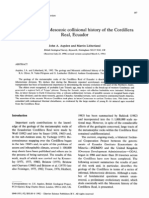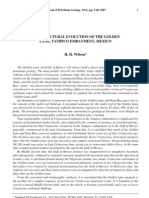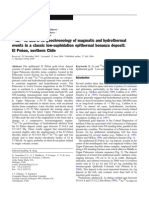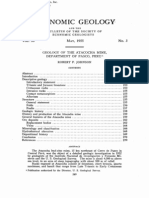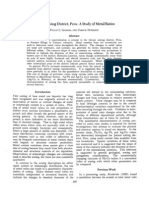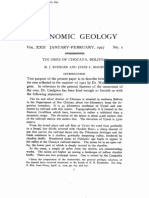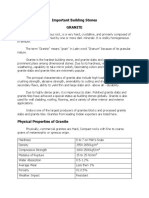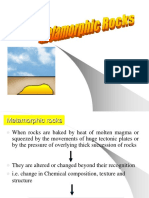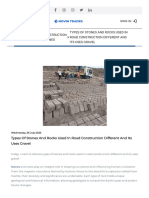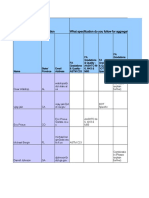Occurrence AND Age of Tin Mineralization IN: Economic Geology Vol. 78, 1983, PP 514-520
Occurrence AND Age of Tin Mineralization IN: Economic Geology Vol. 78, 1983, PP 514-520
Uploaded by
Harold G. Velasquez SanchezCopyright:
Available Formats
Occurrence AND Age of Tin Mineralization IN: Economic Geology Vol. 78, 1983, PP 514-520
Occurrence AND Age of Tin Mineralization IN: Economic Geology Vol. 78, 1983, PP 514-520
Uploaded by
Harold G. Velasquez SanchezOriginal Title
Copyright
Available Formats
Share this document
Did you find this document useful?
Is this content inappropriate?
Copyright:
Available Formats
Occurrence AND Age of Tin Mineralization IN: Economic Geology Vol. 78, 1983, PP 514-520
Occurrence AND Age of Tin Mineralization IN: Economic Geology Vol. 78, 1983, PP 514-520
Uploaded by
Harold G. Velasquez SanchezCopyright:
Available Formats
EconomicGeology
Vol. 78, 1983, pp 514-520
OCCURRENCE
AND
AGE
OF
TIN
MINERALIZATION
IN
THE CORDILLERA
ORIENTAL,
SOUTHERN
PERU
ALAN H. CLARK, VICENTE V. PALMA, DOUGLAS A. ARCHIBALD, EDWARD FARRAR,
Department of Geological Sciences, Queen'sUniversity,Kingston,Ontario K7L 3N6, Canada
MARIO J. ARENAS F.,
Ge6logoConsultor,Caminosdel Inca 698, Lima 33, Perd
AND RONALD C. R. ROBERTSON
AGIP Canada,2700 ScotiaCentre, 700 2nd Street S.W., Calgary,Alberta, Canada
Introduction
The "tin-silverbelt" (Turneaure, 1971) of the Cordillera Oriental (Eastern Cordillera) of western Bo-
livia haslongbeenrecognized asan areallyrestricted metallogeneticsubprovinceof the central Andean orogen.Recentgeochronological studies (Clark and
Farrar, 1973; Evernden et al., 1977; Grant et al., 1979;
McBrideet al., in press) haveshown that felsicmagmatism andassociated hydrothermal tin-polymetallic mineralization in thisregion occurred alonga narrow longitudinalbelt, close to the inner (i.e., eastern) boundary of the orogen, in threeepisodes: the Middle to Late Triassic(225-200 m.y.), the late Oligocene to early Miocene(29-19 m.y.), and the middleto late Miocene (17-12 m.y.). The tin belt experienceda southward migrationof igneous and hydrothermal activity,although at 18 S thereisan en echelon areal overlap(McBrideet al., in press) of the two younger subprovinces distinguished by Grant et al. (1979). Moreover,tungstenand antimony-bearing, possibly Late Tertiary, subvolcanic centers cropout alongthe
is one of severalcomplex polymetalliclode systems underdevelopment in the Cordillerade Carabaya. The occurrence of significant amounts of tin in base metal oresin PunoDepartmentwasfirstrecorded by Raimondi(1878), who examinedPb- and Sb-richvein samples from the Vilquechicodistrict, situatedclose to the northernshoreof Lake Titicaca. Subsequently, at Cerro Calvario in the samearea, de Romafia(1908) observed thin veinlets,apparentlyof Sn-Pbsulfides. Although that authorconsidered there waslittle convincingevidence of the extension of the Boliviantin belt into southeastern Peru, Petersen(1960) was able
to record seven further occurrences of tin minerals
in the region, includingboth bedrockand fluvioglacial deposits. Moreover, limited productionhad taken place from the latter. The San Rafael deposit was apparently first recordedas containingtin by Zambrano et al. (1965),while Rodriguez (1966)tabulated several new localities at which tin occurs in
the region.The CordilleraOriental of PunoDepartment is definedas a tin-polymetallicsubprovince on the 1:2,500,000 metallogenetic map of Peru (Bellido northeastern shore of Lake Titicaca in northwestern et al., 1972), but systematic treatment at that time Bolivia (Ahlfeld and Schneider-Scherbina, 1964), at was hindered by the lack of reliable informationon the samelatitudes asthe Triassic plutons of the Cor- eventhe locations of someof the Sn-bearing deposits. dillera Real (Fig. 1). The Cordillera Oriental is bounded, to the southThe limited southward prolongation of the Andean west,by the northernextremity of the elevatedA1tin belt into northwestern Argentina is apparently tiplano basin, whereas,on the northeasterly flank, well delimited (Ahlfeld, 1967),but its northwardex- altitudes fall abruptlyto the sub-Andean rangesand tension into southeastern Peru is poorlydefined(Pe- the headwaters of the Rio Inambarl and its tributaries tersen,1972). In recentyears,however,thissegment (Fig. 2). MostknownSn-bearing deposits are located of the PeruvianCordilleraOriental, and particularly on the southwesterly slopes of the main, ice-cladCorthe Cordillerade Carabayadistrict(lat 14 to 14$0'S dillera de Carabaya,at altitudesof up to 5,000 m. long70 to 7045'W:Fig. 1), hasemerged as a sigWe are engagedin an investigation of the geonificant source of tin concentrates. The San Rafael chronology, petrochemistry, and metallogenetic remine in northernPuno Department (lat 1412'00"S, lationships in the Cordillerade Carabaya(Robertson, long7020'15"W; Fig. 2), operated by Minsur,S. A., 1978; Palma, 1981; Palma and Clark, 1982; Clark et was formerly a modestcopper producerbut has al., 1982;D. J. Kontak,unpub.studies), involving a with the better known northern Bolivian yieldedover 10,000metrictonsof cassiterite concen- comparison trates(avg.gradeca. 42.2% Sn) since1970. Produc- segment of the tin belt. In the presentcommunication in 1981 amounted to 1,500 tons of Sn metal tion, we providethe first geochronological evidence (Minsur,S. A., unpub.repts.).The SanRafaeldeposit for the age of tin-polymetallic mineralization in this
061-0128/8/151/514-752.50 514
SCIENTIFIC
COMM UNICA TIONS
515
little known but extensively mineralizedarea of the central Andes. ConventionalK-Ar mineral ages are presented for the producingSan Rafael Sn-Cu vein systems and for the SantoDomingoSn-Cu-Pb-Zn-Ag prospect, locateda shortdistance to the westof the former mine (Fig. 2).
",
70 :i.
69 1
'"'.d,o
'-
The K-Ar ages(by D. A. A. and Geochron Laboratories)were determined following standardtechniques,usingthe reviseddecayconstants of Steiger
I /
and Jiger(1977),and are referredto the time scale of Van Eysinga(1975).
Geologic Setting
,,-. ....
-_-.-/
F'-S.
.,.
' L'%7
'.*'-'
''
Althoughthe study area has receivedcomparatively little detailedgeologic investigation, the major relationships are definedon the 1:1,000,000 geologic map of Peru (INGEOMINAS, 1975).Recently, Laubacher(1978)hasprovideda 1:500,000 geologic map of part of the CordilleraOrientalof PunoDepartment and a description of the pre-Cenozoic evolutionof the area, updating the pioneeringwork of Newell (1949)and Newell et al. (i955). Stewartet al. (1974), Lancelotet al. (1978), and Audebaudet al. (1979) havereported radiometric ages for granites andother igneous rocksin the region. The geologic historyof the CordilleraOrientalin
southeastern Peru is summarized in Table 1 and will
ue
O_
. -I_&
-/O,
'
F(;. 2. Morphostructural provinces in southeastern Peru,with
locations of the San Rafael mine and Santo Domingo prospect. Modified after Laubacher (1978).
livia but is generallymore complete.Large areasare be discussed only briefly herein. The stratigraphic underlainby lower and upper Paleozoic strata(Laurecord is similar to that in the Cordillera Real of Bo- bacher, 1978) and recordtectoniceventsof both Andean (i.e., Middle Triassicand younger)and pre-Andean (Hercynian: M6gard et al., 1971) orogenies. It
is evident that intrusive and volcanic rocks were emSAN
RAFAEL
/
-'
Ii
200 km
I
take
18
MD UPPER PERMIANTRIASSIC PLUTONS
(+W-Sn) 202-225 Ma
ORURO & 1[.3
.
S II-I [MD.-UP. TRIASSIC PLUTONS [ UP. OLIGO.LR.(+Sn-W) MIOCENE PLUTONS
22'
'- LRMIOCENE }SUB - Sn [- UP. MIOCENE VOLCANIC
Fit;. 1. Generaldistribution and agerelations of intrusivebodies and mineralizationin the tin-polymetalliebelt of the central Andean Cordillera Oriental, with the location of the San Rafael deposit. Modified after, inter alia, Evernden et al. (1977), Grant et
placed both in the Carboniferous-Triassic interval, i.e., at the closeof the younger of the pre-Andean tectoniccycles,and in the Cenozoic,as an integral part of the Andeanorogeny.Each igneous suitedisplaysa wide compositional range, from gabbros and diorites to monzogranites (Streckeisen, 1967). The pre-Andean volcano-plutonic bodiesare more voluminousthan the Andean, and all large granitoid intrusionsare of Permo-Triassicage (Stewart et al., 1974; Lancelotet al., 1978; Laubacher, 1978). The agesof intrusionof the probably numerous (Laubacher,1978) Andean plutonsin this region are in part constrained by their stratigraphicrelationships,as in the Precordillerade Carabaya (Fig. 2; Laubacher, 1978), where severalsmall stocks intrude
Cretaceous sediments. In the main Cordillera de Car-
abaya,however, the graniticrockswere emplacedin Paleozoic strataand could,therefore,be of any postPaleozoicage. It hasbeen assumed that the majority of plutons are of Oligocene or Mioceneage (Petersen, 1960;Laubacher, 1978)because they are inferredto
postdate the postulated middle to late Eocene(Incaic) episodeof Andean deformation.This interpretation is not convincingly supported by stratigraphic or tec-
al. (1979),and Laubaeher (1978).Numbers on Oligoeene-Mioeene plutonsin Boliviaare ages(in m.y.) from McBride et al. (in press).
516
SCIENTIFIC
COMM UNICA TIONS
TABI.E1. SimplifiedStratigraphic Column,Cordillerade Carabaya, Southeastern Peru Modifiedafter Laubacher, 1978;plutonicrocksomitted.
Approx.
thickness
Formations and lithologies
Miocene-Pliocene
Cretaceous
(m)
<:300 <1,100
Felsicignimbrites Cotacucho Group (sandstones, dolomites)
Hiatus
Late
Permian
Mitu Group (volcanics,red beds)
<:3,000
Late Hercynian deformation
PennsylvanianEarly Permian
Mississippian
Tarma-Copacabana Group (sandstones, shales limestones) Ambo Group (sandstones, shales)
>2,000
rems,particularly thosein which copper and tin are abundant,showa spatialassociation with granitic intrusions. Severalof thesedistricts displaymetal zonation patterns, showing, for example,Cu and Sn concentratedwithin and adjacentto the plutons,whereas Pb, Zn, and Ag occurin peripheralareas(D. Kontak, unpub.studies). Several smallvein and skarndeposits, includingsomeof tungsten and copper,are located within or adjacent to largegranitoidplutons of Permian or Triassic age, suchasthe Coasabatholith(Laubacher,1978),but the magnitudeof the Permo-Triassic metallogenetic episode is undefined.The known tin-polymetallicdeposits of proven or probablepotential in the Cordillera de Carabaya are associated with youngergraniticintrusions emplacedduring the Andeanorogeny.These include the San Rafael SnCu deposit(and, almostcertainly, the nearby Quenamari, or Mina Carabaya,Sn-Cu-Pb-Zn-Ag district) and the SantoDomingoSn-Cu-Pb-Zn-Agvein system. San Rafael district
> 1,500
Early Hercynian deformation
Siluro-Devonian
Caradocian
Ananea Formation (shales)
>2,500
SandiaFormation (shales, quartzites)
:3,500
LlanvirnianLlandeillian
SanJos( Formation (shales)
:3,500
This intensely mineralizeddistrict(Fig. $) hasbeen mappedby N. Roldn (unpub.rept.) and, morecomprehensively, by Arenas (1980). Palma (1981) has carriedout a mineralogical and fluid inclusion study of the mineralization (see Palma and Clark, 1982). The SanRafaeland Quenamari(Carabaya)minesare
situated at altitudes of over 4,500 m above sea level
Basementnot exposed
on the slopes of the snow-capped NevadoBartolom( de Quenamari, in Melgar Province.At San Rafael, mineralizationhas been exploitedover a vertical interval of 500 m.
tonic relationships in the immediate study area but
has nevertheless been confirmedby our geochronologicalstudies. The mostvoluminous Andeanigneous bodies in the Cordillera de Carabaya are probably the thick and areallyextensive sequences of felsicperaluminous ignimbrites (Francis, 1959; Laubacher, 1978), which
All known mineralizationat SanRafael and Quenamari is localizedin steeplyinclined veinsand strucrurallycomplex lodes, with longitudinal extensions of up to $ to 4 km. Mostof the veinstrend northwesterly and, althoughconcentrated in the immediate vicinity
of two small(<1 km2) stocks of granite,appearto be
controlledby regional shear systems. The country are of Mioceneto Plioceneage (Barnes et al., 1970; rocksare slates,phyllites,and quartziteswhich disNoble et al., 1982). play evidence of at leasttwo periods of strong folding and,on structural and paleontological grounds (Palma, Mineralization 1981),are assigned to the Late Ordovician.It should map A wide range of metallic mineralizationis repre- be notedthat Laubacher(1978), in his geologic sented in the Cordillera Oriental of Puno Depart- of the Cordillera Oriental, does not recognizethe ment, but productionto date has been limited. In occurrence of lower Paleozoic strata in this area and the areal extent of the granitic addition to the San Rafael Sn-Cu deposit,there has stronglyexaggerates longbeena modest recovery of gold from veinsand, stocks. The SanRafael and Quenamariintrusions are premore widely, fiuvioglacial gravels. Several small of peraluminous coarse-grained minesare currentlyproducing Pb-Zn-Agconcentrates dominantlycomposed in both the Cordillera de Carabaya and the Precor- alkali feldspar-megacrystic biotite monozogranites, dillera de Carabaya,as well as in the contiguous AI- containingabundanteuhedralcordieriremegacrysts tiplano. and minorsillimanite. In their mineralogy and chemThe great majority of the deposits are vein type, istry (Palma,1981),theserocks conformto the S-type although several strata-bound Pb-Zn-Ag,Cu, and Mn and ilmenite seriesclans of Chappell and White centersare known. Baseand precious metal vein sys- (1974) and Ishihara(1977), respectively.
SCIENTIFIC
COM M UNICA TIONS
517
Palma(1981)distinguishes fourmajorstages of vein development in the largeSanRafaellode,asfollows: (1) early, essentially barren, quartz-tourmaline veinlets and brecciabodies;(2) a botryoidalcassiteritequartz-chlorite stage, in whichthe bulk of the tin was deposited;((3) a chalcopyrite-"needle tin"-quartz chlorite stage;and (4) minor, unmineralized,late quartz-calcite veins.In the SanRafael lode theseepisodes of mineralization were superimposed, leading to the developmentof complex vein fabrics, with widespread fine brecciationand wall-rock replacement, similar in many respects to thoseof the major Sn-Cu lodesof Cornwall-Devon,England (Hosking,
1969). Asnotedpreviously, the mine beganoperations as a copperproducer,and only beganto yield substantialamounts of cassiterite in the early 1970s.The trend reflectsan unusuallyclear-cut vertical metal
zonation (Arenas,1980) in which copper overliestin,
againaslocallyin Cornwall,England.The transition from the tin to the copper zonesin the San Rafael lode is at ca. 4,600 m abovesealevel, and stoping has
beencarried out from the 4,555-m level to just below
5,000 m above sea level.
Fluid inclusionstudiesby Palma (1981) demonstratethat the bulk of the tin and copper were depositedfrom nonboilinglow-salinityfluids at moderatetemperatures (ca.220-$90C)and at very shallow depths (confining pressures<$00 bars). The emplacement of the SanRafael stockis alsoinferred to havetakenplacevery close to the surface, although there are no local, or regional, exposures of coeval
volcanic rocks.
LEGEND
U..ER OLE.E- LOWE. 'E"E
VICIAN
SKETCH
OF
PALEOZC METASEOIMENTS (MAINLYSAN SANA FATION
VEINS ANO LES
RAFAEL MINI
O 0.5
km
STRICT
LAKES
The nearby Quenamari (Carabaya) vein system ing district.Modifiedafter N. Roldfin(unpub.repts.)and Arenas (Fig. $) shows many featuresin commonwith the (1980). San Rafael district,in that tin and copperare abundant metals, but recentproduction hasbeenrestricted to zinc and argentianlead concentrates. In contrast therefore, lower Paleozoicsediments,overlain to the of the Mississippian Ambo to San Rafael, the individual veins, exposed over an southby clasticsediments elevation interval of some 250 m, show little metal Group.Theseare intrudedby several smallstocks and dikes of coarse megacrystic cordierite monzonation;thus, the Nazareth vein (Fig. (3) is appar- numerous ently rich in Zn, Pb, and Ag along its entire strike zogranite,very similar to that of the San Rafael and lengthof over4 km and between4,690 and 4,922 m Quenamari plutons. The major vein recognized to date, the SantoDoabove sealevel,whereas the adjacent Quenamarivein mingo,hasbeentracedfor over $ km and ranges is Cu and Sn bearingthroughout.
from 50 cm to over 5 m in width. At least in its south-
Flo. 3. Geologic sketch map of the SanRafael-Quenamari min-
Santo Domingo deposit
eastern portion,oresof Cu, Sn, Pb-Ag, and Zn are associated, andthus themetalzoning charThis Sn-bearing polymetallic center (14012 ' S; intimately acteristic of the San Rafael lode is not shown at the 700(32 ' W), under active developmentby Minsur, levels.The SantoDomingovein is structurS. A., is located 20 km to the west of San Rafael, at exposed showing evidence of several episodes altitudes of between 4,600 and 5,000 m above sea ally complex, of fracturingand mineralization. level on the southern flanks of Cerro Ccasahuallata. Reconnaissance geologicstudiesof the mineralized Sample Locations and K-At Data zonehave beencarriedout by geologists of Minsur, S. A., and by M. J. Arenas.A series of northwest- San Rafael trending steeply inclined veins (Fig. 4) cross-cut At San Rafael, our intention was to establish the weakly metamorphosed but multiply deformedand, ageof intrusion of the monozogranite and to delimit
518
SCIENTIFIC
COMM UNICA TIONS
LEGEND
MIOCENE GRANITC)D INTRUSIONS
UPPER OLIGOCENE - LOWER
SKETCH
OF
MAP
GRANITOID DIKES PALEOZOIC METASEDIMENTS VEINS
RIVERS
SANTO DOMINGO PROSPECT
1
km
2
I
marginalchloritization, the potassium contents of the analyzedfractionssuggest that thesemicasare acceptably fresh. The three biotiteages, determinedat Queen'sUniversity (24.0 and 23.7 _ 0.6 m.y.; error expressed as 2a), and by GeochronLaboratories (25.9_ ca. 1.0 m.y.; recalculated, followingSteiger andJiger, 1977, from Arenas,1980), althoughnot identical,suggest that intrusionof the San Rafael stocktook place in the latest Oligocene.All three age determinations appear valid from the analytical standpoint,and the minor discrepancies betweenthem may reflect thermal resetting, perhaps duringquasi-pervasive, preore, high-temperature hydrothermal activity (Palma, 1981).The depthof emplacement of the granitecannot be directlyestimated but is unlikelyto havebeen great, and it is inferred that intrusionand consolidation of the pluton occurredat 25 to 26 m.y. The age of hydrothermalmineralizationat San Rafael is estimatedfrom analysisof a specimenof massive milky-white adularia.The unalteredfeldspar is intergrownwith quartz and is associated with chalcopyrite,sphalerite,galena,and chlorite;it was collectedduringJuly 1979 from the "north" end of the 4,820-madit on the Jorgevein. Crystallization of the feldspartook place late in the emplacementof the third Cu-rich stageof lode development (Palma, 1981).The adulariahasa monoclinic (highsanidine)
crystal structure, andprobably resisted AI, Siordering
owingto rapid coolingfrom its depositional temper-
The apparent ageof the adularia, 22.6 _ 0.5 m.y. (Table 2), falls at the Oligocene-Miocene boundary the interval between magmatic and hydrothermal but isnotsignificantly younger thanthe apparent age events. Three samplesof magmatic biotite in the of at least one of the magmatic biotites. The granitewere dated (Table 2); thesewere takenasfar shallowdepth of emplacementof the San Rafael ores
as possible from the main San Rafael lode or subsid- and the moderatetemperatureof mineralizationimiary veins,on the 4,660- and 4,555-m levelsof the ply that the adularia K-Ar age providesa reliable mine. Although biotite in the stock widely shows estimate of the time of ore formation. If the oldest
TABLE 2. K-Ar Age Determinations, San Rafael and Vicinity, Peru
FI(;. 4. Geologic sketchmap of the SantoDomingoprospect ature of ca. $00C. area. Modified after M. J. Arenas(unpub. rept.).
Analysis no.
Specimen no.
Mineral analyzed
%K
4hr(rad) cm NTP/g
% 4Ar (arm.)
Age"and error (m.y.)
San Rafael deposit
1 B-4850 Biotite 7.209 7.115 )< 10 4, 52.2 25.9 1.0
2 $ 4
SARL-457 SARL-259 SARL-4$4
Biotite Biotite Adularia
7.216 7.446 11.464
6.767 )< 10 ' 6.911 )< 10-4' 10.141 )< 10 '
$6.2 41.1 10.2
24.0 0.6 23.7 +__ 0.6 22.6 +__ 0.5
SantoDomingo deposit
5 SD-7
Biotite
7.189
6.841 X 10 -4'
13.9
24.3 0.6
Analysis 1 by Geochron Laboratories, remainderby D. A. Archibald; analysis 4 is for vein adularia,othersamples are for magmatic biotite in monzogranite
"Ageswerecalculated using the constants suggested by Steiger andJiger (1977); errors represent the analytical precision at 2a
SCIENTIFICCOMMUNICATIONS
519.
biotitedate(25.9+_1 m.y.) may be regarded asprovidinga minimumagefor intrusion, theadularia date wouldbe in permissive agreement with a modelinvolvinga hiatusof ca. 2 m.y. between graniteemplacement and stage $ mineralization.
Santo Domingo
penetrating in some transectsto over 500 km from
the continental margin (Clark et al., 1976;Clark and
two centerswas essentiallycontemporaneous. The throughthe Miocene (Everndenet al., 1977; Grant similarities in the styleof mineralization in thesedis- et al., 1979;McBrideet al., in press). However,the trictsalsosuggest that they may be assigned to the ages determined for the importantSanRafaeldeposit samemetallogenetic episodeand district. andfor theSanto Domingo prospect show clearly that this time-spacepattern is not extrapolatednorthDiscussion:Regional Relationships westward alongthe Peruviansegment of the belt. The K-Ar age data presented herein demonstrate Thesepolymetallic vein systems are coevalwith the that, although somemineralization in the Cordillera mostproductive of the tin vein deposits in the plude Carabaya is certainly of Permo-Triassic ,age, the tonic subprovinceof northern Bolivia, i.e., in the
The K-Ar biotiteage of 24.$+_ 0.6 m.y. is very of the tin belt in Bolivia was reactivated in the late similar to those reported above for themagmatic bio- Oligocene (28-29 m.y.), presaging a broadsouthward titesfrom SanRafael,implying that intrusion in the movement of magmatic and hydrothermal activity
At thisprospect we haveobtained an ageonlyfor cordillera(R. M. Tosdal,A. H. Clark, and E. Farrar, magmatic biotite.The analyzed specimen (Table 2) unpub.data). There is, however,only limited eviwascollected from a narrow,coarse-grained, mon- dence of metallicmineralization of thisage in the zogranitedike locatednear the southernlimit of the Cordillera Occidental of southern Peru,perhaps remineralized district. Thisrockis slightly chloritized, flectingthe restricted exposure of intrusive bodies. but the biotite is fresh. Asnoted in theintroduction, thenorthern segment
McNutt, 1982).Thisepisode hasbeententatively ascribedto the immediately preceding reorganization of plateconfigurations in the contiguous eastern Pacific basin, and coincided with widespread physiographicuplift throughout the westernand eastern
to 28.$ (+_1) m.y. for basaltic and trachytic volcanics may be widely separated from those of northernBonearthe southwestern marginof the CordilleraOri- livia. ental,andof 22.0 to 26.0m.y. for several smallstocks
mostimportantmetallogenetic eventso far recog- CordilleraQuimsaCruz (McBrideet al., in press) nizedin the region occurred in the late Oligiocene some450 km to the south.As far as is known, there (ca.26-25 m.y.).No otherdates havebeenreported arenosignificant Oligocene-Miocene tin-bearing cenfor ore deposits in thisregion, but Audebaud et al. tersin thenorthwesternmost segment of the Bolivian (1979) havedetermined K-Arages in therange 25.6 tin belt, sothat the mid-Tertiarytin veinsof Peru
Acknowledgments
of gabbroic or granitic composition in thesame gen-
Field studies in Peru were fundedby grantsto eral region.Thus,the Sn-polymetallic mineralization Sciences andEngineering was associated with a magmaticepisode which af- A.H.C.fromthe National Councilof Canada,as part of the Central fected wide areasof the Cordillera Oriental of south- Research Project (CAMP). The same eastern Peru. Volcanism persisted in this region AndeanMetallogenetic
firmed in this area.
through the Neogene and,locally, intothe Quaternary (S. L. McBride,unpub.data),but asyet there is no definite evidence for post-Oligocene mineralization; thus,the middleto late Miocene episode of Cu-Pb-Zn-Ag-Au oreformation distinguished in central Peru(e.g., McKee et al., 1979) has yetto becon-
bodysupported laboratory studies, through grants to
E.F. and A.H.C.
Field work in the Cordillerade Carabayawould not have beenpossible withoutthe generous cooperation of Minsur, S.A. We are particularly indebted to FaustoZavaleta,GerenteGeneral,for permission to undertake thisresearch and to publish thiscontri-
cordillera) experienced a radical arealbroadening,
Simultaneously with the late Oligocene initiation bution. At SanRafael, we receivedthe kind assistance Adolfo Mdico, JulverAlvarez, of magmatic andhydrothermal processes in the Cor- of NestorRoldftn, Luque.The earlierstages of dilleraOrientalof the studyarea,thereoccurred a Hugo Cruz, and Pastor with regional reactivation of thecentral Andean magmatic the programwere carried out in collaboration of the former InstitutoCientificoy arc in areas as widely separatedas southernPeru Flavio Estrada, Minero del Per6. (Nobleet al., 1974;Tosdal et al., 1981),and north- Tecno16gico ernmost (Mortimeret al., 1974)and northern(Clark et al., 1976;Quirt, 1972)Chile.At thistime (ca.26- August 6, December 1, 1982 REFERENCES 20 m.y.)thepreviously narrow, longitudinal, volcanoplutonic belt of the Cordillera Occidental (western Ahlfeld, F., 1967, Metallogenetic epochs and provinces of Bolivia:
Mineralium Deposita,v. 2, p. 291-$11.
520
SCIENTIFIC COMMUNICATIONS
Ahlfeld,F., and Schneider-Scherbina, A., 1964,Losyacimientos
minerales y de hidrocarburos de Bolivia:BoliviaServicio Geol., Bol. 5, 888 p. Arenas,M. J., 1980, E1distrito minero San Rafael, Puno:estafioen el Per6: Soc.Geol. Per6 Bol., v. 66, p. 1-12.
Antaminadistrict,northernPeru:ECON. GEOL.,v. 74, p. 928980.
Mgard, F., Dalymayrae,B., Laubaeher, G., Maroceo, R., Martinez, C., Paredes, J., and Tomasi,P., 1917, La ehanehereyninneau
Prou et en Bolivie: Premiers resultats:France, Office Recherche Sci. Tec. Outre-Met, Cahiers, Ser. Gol., v. 18, p. 5-44.
Audebaud, E., Bernard, D., Vatun-Perignon, N., and Vivier,G., 1979,Quelques ages K/Ar surlesroches ign6es cnozoiques du
S.E. Pruvien:Consequences g6odynamiques: Paris,Sci. Terre,
Mortimer, C., Farrat, E., and Satin, N., 1974, K-At ages from Tertiary lavas of the northermost Chilean andes:Geol. Rundschav,v. 68, p. 484-490. Ann. Rept. 1969. Barnes, V. E., Edwards, G., McLaughlin, W. A., Friedman,I., and Newell, N. D., 1949, Geologyof the Lake Titicaca region,Peru Joensuu, O., 1970,Macusanite occurrence, age,andcomposition, and Bolivia:Geol. Soc.AmericaMem. 86, 111 p. Macusani, Per6:Geol.Soc.AmericaBull.,v. 81, p. 1589-1546. Newell, N. D., Chronic,J., and Roberts,T., 1958, Upper Paleozoic Bellido, E.,Girard, D.,and Paredes, J.,1972, Mapa metalog6netico of Per6: Geol. Soc.America Mem. 58, 276 p.
Earth Planet. Sei. Letters, v. 21, p. 218-220. types:PacificGeology,v. 8, p. 178-174. P.S., Vogel, T. A., Landis,G. P., Grant, Clark,A. H., andFarrar,E., 1978,The Bolivian tin province: Notes Noble, D. C., Petersen, N. K., and Jezek,P. A., 1982, Rare-element-enriched ilmeniteon the available geochronological data: Ecor. GEOL., v. 68, series ash-flowtuffs containingphenocrystic muscovite, andap. 102-106. Macusani region,southeastern Perulabs.l: Clark,A. H., andMcNutt,R. H., 1982, Interrelated arc-broadening, lusite,and sillimanite, Geol. Soc.America, Abstracts with Programs, v. 14, p. 577. topographic uplift,andcrustal contamination of magmas in two transects of the Mesozoic-Cenozoic centralAndes labs.l: Internat. Palma, V. V., 1981, The San Rafael tin-copperdeposit,Puno, S. E. Peru: Unpub.M.Se.thesis, Queen'sUniv., Kingston, OnConf.Geochronology, Cosmochronology, Isotope Geology, 5th, tario, 225 p. Nikko, Japan,June27-July 8, 1982, Abs.,p. 55-56. Clark, A. H., Farrat, E., Caelles, J. C., Haynes,S. J., Lortie, R. B., Palma V. V., and Clark A. H., 1982, The San Rafael tin-copper lode system, Puno,S. E. Per6: A Cornwall-type deposit in the McBride, S. L., Quirt,G. S., Robertson, R. C. R., andZentilli, centralAndeantin belt:Geol.Assoc. Canada/Mineralog. Assoc. M., 1976,Longitudinal variations in themetallogenetic evolution Canada,Joint Ann. Mtg., Winnipeg 1982, Programwith Abof the Central Andes: A progress report:Geol. Assoc. Canada
Spec. Paper 14, p. 28-58.
stracts, p. 71.
del Per6:Lima,Per6,Servicio Geologla. Mineria,1:2,500,000. Noble, D.C., McKee, E. H., Farrat, E., and Petersen, U., 1974, Episodie Cenozoicvolcanism and tectonism in the Andesof Peru: Chappell, B.W., andWhite, A.J.R., 1974, Twocontrasting granite
Clark, A. H., Kontak,D. J., and Fartar, E., 1982,Metallogenetic en el Per6:Soe.Nae. Minerla Bol.,v. 72, ser.2, p. 86-44. and geochronological relationships in the northernpart of the Petersen, U., 1972,Geochemical and tectonicimplications of South central Andean tin belt, southeastPer6 and northwest Bolivia
Petersen, G., 1960,SobreCondoriquefia y otrosdepositos de estafio Americanmetallogenie provinces: New York Aead. Sei. Ann., v.
196, p. 1-88.
labs.l: Internat.Assoc. Genesis Ore Deposits Symposium, 6th,
Tbilisi, U. S. S. R., 1982, CollectedAbs.,p. 64-65. Quirt, G. S., 1972,A potassium-argon geochronologieal investigade Romafia, E. A. L., 1908,Una inspeccibn de losyacimientos de tion of the Andeanmobilebelt of north-central Chile: Unpub. estafio de Bolivia y una exploraci6n por el mismometal en el Ph.D. thesis, Kingston, Ontario, Queen'sUniv., 240 p. Per6:Per6 Cuerpo lngenieros de Minas, Bol. 57. Raimondi, A., 1878,Minerales del Per6 o catalogo razonado de una Evernden,J. E., Kriz, S. L., and Cherroni,C., 1977, Potassiumeoleccibn que representa losprincipales tiposde minerales de la argon ages of some Bolivian rocks: ETON. GEOL., v. 72, p. 1042rep6bliea, con muestras de guanoy avesque 1ohah produeido: 1061.
Robertson, R. C. R., 1978, Metallogenetie reconnaissance of the del surPer6:Per6,Inst. Nac. lnvestigaci6n Fomento Mineros, Cordillera de Carabaya: Unpub.rept., Lima, Inst.Cient. Tech. Bol. 21, p. 18-82. Mineria, 40 p. Grant,J. N., Halls, C., Avila-S.,W., and Snelling, N. J., 1979, K- Rodriguez, J. R., 1966, Estudiopreliminar para equipamiento de Ar ages of igneous rocks andmineralization in partof theBolivian minasde la cooperativeminera "Arieoma": Ministerio Fomento tin belt: ECON.GEOL.,v. 74, p. 888-851. ObrasPublieos, Unpub. rept. Lima, Per6, no. 154. Hosking, K. F. G., 1969,The natureof the primarytin ores of the Steiger, R. H., and J/iger, E., 1977,Submission on geochronology: south-west of England: Tech.Conf.on Tin, 2nd,Bangkok 1969, Convention on the useof decayconstants in geo- and eosmov. 8, p. 1155-1244. chronology: Earth Planet.Sci.Letters,v. 86, p. 859-862. INGEOMINAS, 1975,Mapa geo16gieo del Peril (1:1,000,000): Per6 Stewart, J. W., Evernden, J. F., and Snelling, N.J., 1974, Age Inst. GeologiaMinerla. determinations from Andean Peru:A reconnaissance survey: Ishihara, S.,1977, Themagnetite-series andilmenite-series granitic Geol.Soc.AmericaBull., v. 85, p. 1107-1116, rocks: Mining Geology, v. 27, p. 298-805. Streckeisen, A., 1967,Classification and nomenclature of igneous Lancelot, J. R., Laubaeher, G., Maroceo,R., and Renaud,U., 1978, rocks: Neues Jahrb.Mineralogie Abh., v. 107, p. 144-240. U/Pb radiochronology of two graniticplutons from the Eastern Tosdal, R. M., Fartar,E., andClark,A. H., 1981,K-Ar geochroCordillera (Per6): Extent of Permian magmatic activity andconnologyof the late Cenozoic volcanic rocks of the CordilleraOcsequence: Geol. Rundsehau, v. 67, p. 286-248. cidental,southernmost Peru: Jour. Volcanol.Geotherm.ReLaubacher, G., 1978, Estudio geo16gico dela region notre delLago search,v. 10, p. 157-178. Titicaca:Per6 Inst. Geologia Mineria Bol. 5, 120 p. Turneaure,F. S., 1971, The Boliviantin-silverprovince:ECON. McBride, S. L., Robertson, R. C. R., Clark, A. H., and Farrar, E., GEOL., v. 66, p. 215-225. in press,Magmatie and metallogenetie episodes in the northern Van Eysinga, F. W. B., 1957,The geological time table:Amstertin belt, Cordillera Real, Bolivia: Geol. Rundschau.
dam, Elsevier.
Francis,G. It., 1959, Ignimbritas(sillar)de la Cordillera Oriental
Lima, Per6.
McKee,E. H., Noble,D.C., Seherkenbach, D. A., Drexler,J. W.,
Zambrano, R., Lavi, P., and Eyzaguirre, R., 1965,Programa de Mendoza, J.,andEyzaguirre V. R., 1979, Ageof porphyry ininventario y evaluaci6n de losrecursos naturales del Depto.de trusion, potassic alteration, and related skarn mineralization, Puno--Capitula 8: Geologla y Recursos Mineros, v. 2, p. 42.
You might also like
- 2008 Lexicon of Philippine Stratigraphy by Rolando PeñaDocument7 pages2008 Lexicon of Philippine Stratigraphy by Rolando PeñaPatricia Lynn GonoNo ratings yet
- Metallogenic EvolutionDocument64 pagesMetallogenic EvolutionRupert NightfallNo ratings yet
- Schultz Et Al 2004Document18 pagesSchultz Et Al 2004dedibolaNo ratings yet
- De Oliveira, S. Et Al. (2021)Document20 pagesDe Oliveira, S. Et Al. (2021)williams mataNo ratings yet
- GeocronologiaDocument64 pagesGeocronologiayaku1618No ratings yet
- Cordillera Real GeologyDocument18 pagesCordillera Real GeologyLuis MatuteNo ratings yet
- Miocene Intrusions of The Central Andes: Preliminary Geochemistry and U/Pb GeochronologyDocument4 pagesMiocene Intrusions of The Central Andes: Preliminary Geochemistry and U/Pb Geochronologypaulo de carvalhoNo ratings yet
- 2001 .Marschik & Fontboté. The Punta Del Cobre FormationDocument33 pages2001 .Marschik & Fontboté. The Punta Del Cobre FormationrodolfoNo ratings yet
- Aspden & Litherland, 1992Document18 pagesAspden & Litherland, 1992Kvn VqzNo ratings yet
- 2005 Polliand PeruDocument12 pages2005 Polliand PeruRossiogioNo ratings yet
- Structure and Age of The Cerro de Pasco Cu-Zn-Pb-Ag Deposit, PeruDocument9 pagesStructure and Age of The Cerro de Pasco Cu-Zn-Pb-Ag Deposit, PeruChristoforus D TeachNo ratings yet
- Espeche y LiraDocument2 pagesEspeche y LiramaríaNo ratings yet
- Quaternary Stratigraphy of AlaskaDocument35 pagesQuaternary Stratigraphy of AlaskaBaculitesNo ratings yet
- 2011CarrasqueroetalNeuejahrbuch PDFDocument13 pages2011CarrasqueroetalNeuejahrbuch PDFVíctor Adolfo ValdiviaNo ratings yet
- Camus1990 PDFDocument36 pagesCamus1990 PDFLuis ValdiviesoNo ratings yet
- U-Pb Geochronology and Hf-O Isotopes of Zircons From The Pennsylvanian Coastal Batholith, South-Central ChileDocument34 pagesU-Pb Geochronology and Hf-O Isotopes of Zircons From The Pennsylvanian Coastal Batholith, South-Central ChileDaneel OliwanNo ratings yet
- Mineralisation of Gold in ColombiaDocument4 pagesMineralisation of Gold in Colombiaivanjav1007No ratings yet
- Isotope Characterization of Lead in Galena From Ore Deposits of The Ayseân Region, Southern ChileDocument13 pagesIsotope Characterization of Lead in Galena From Ore Deposits of The Ayseân Region, Southern ChilemanudemNo ratings yet
- Marc Polliand Urs Schaltegger Martin Frank Lluis Fontbote : OriginalpaperDocument12 pagesMarc Polliand Urs Schaltegger Martin Frank Lluis Fontbote : OriginalpaperRichard OsorioNo ratings yet
- AndahuaylasYauri Porfidos 2003Document31 pagesAndahuaylasYauri Porfidos 2003berthingNo ratings yet
- The Relationship Between The Porco, Bolivia, Ag-Zn-Pb-Sn Deposit and The Porco CalderaDocument19 pagesThe Relationship Between The Porco, Bolivia, Ag-Zn-Pb-Sn Deposit and The Porco CalderaGAUCHEX697355No ratings yet
- 1990 Kudrass Et Al. - Volcanic Rocks and Tertiary Carbonates Dredged From The Cagayan Ridge and The SW Sulu SeaDocument8 pages1990 Kudrass Et Al. - Volcanic Rocks and Tertiary Carbonates Dredged From The Cagayan Ridge and The SW Sulu SeaBryan NadimpallyNo ratings yet
- New Mexico Geological Society: The Geology and Petrogenesis of The Capitan Pluton, New MexicoDocument16 pagesNew Mexico Geological Society: The Geology and Petrogenesis of The Capitan Pluton, New Mexicomisael.robles.pucpNo ratings yet
- Mantos de Cu Tipo ChilenoDocument12 pagesMantos de Cu Tipo ChilenoVirgilio Luna HuachacaNo ratings yet
- Winkler Et Al., 2008Document5 pagesWinkler Et Al., 2008JannethNo ratings yet
- Mantilla Et Al 2013 The Magmatic History of The Vetas-California Mining District Santander Massif, Eastern Cordillera, ColombiaDocument49 pagesMantilla Et Al 2013 The Magmatic History of The Vetas-California Mining District Santander Massif, Eastern Cordillera, ColombiaLuis VélezNo ratings yet
- Genesis of Giant San Rafael Tin Deposit Peru-Pervasive AlterationDocument37 pagesGenesis of Giant San Rafael Tin Deposit Peru-Pervasive Alterationgeology1No ratings yet
- The Metallogenic Evolution of The Greater Antilles - Nelson Et Al - GA2011Document36 pagesThe Metallogenic Evolution of The Greater Antilles - Nelson Et Al - GA2011Julieth Caicedo100% (1)
- Copper Skarn DepositsDocument95 pagesCopper Skarn DepositsKevin Y. Cornelio Prado100% (1)
- Early Jurassic Arc Related Magmatism Associated With Porphyry Copper Mineralization at Zafranal, Southern Peru Unraveled by Zircon U-Pb AgesDocument26 pagesEarly Jurassic Arc Related Magmatism Associated With Porphyry Copper Mineralization at Zafranal, Southern Peru Unraveled by Zircon U-Pb Agesdeyvi santosNo ratings yet
- Chiaradia Et Al 2009 NambijaDocument17 pagesChiaradia Et Al 2009 NambijaMichael AltamiranoNo ratings yet
- A Comparison of Stream Sediment and Soil SurveysDocument10 pagesA Comparison of Stream Sediment and Soil SurveysYaminne Laveriano EspinozaNo ratings yet
- Jaillard Et Al., HALDocument19 pagesJaillard Et Al., HALDanielNo ratings yet
- Copia de 2003 Depositos Andes CentralesDocument19 pagesCopia de 2003 Depositos Andes Centralesgeology1No ratings yet
- Articulo Geoquimica Aitchesosn 1995Document4 pagesArticulo Geoquimica Aitchesosn 1995martinNo ratings yet
- 1 s2.0 S0377027301003298 MainDocument40 pages1 s2.0 S0377027301003298 MainLeoonardo EscalanteNo ratings yet
- 2017 LaBodega-SanturbanDocument28 pages2017 LaBodega-SanturbanFabio De Jesus Rios CuitivaNo ratings yet
- Vatin-Perignon +al 1996Document19 pagesVatin-Perignon +al 1996Victor ValdiviaNo ratings yet
- Lavenu Et Al., 1992Document12 pagesLavenu Et Al., 1992FranchescoJohisChsNo ratings yet
- A Paleolimnological Perspective On Industrial-Era Metal Pollution in The Central Andes, PeruDocument11 pagesA Paleolimnological Perspective On Industrial-Era Metal Pollution in The Central Andes, PeruLeochemical ChemicalNo ratings yet
- Amphibolitic Cu-Fe Skarn Deposits in The Central Coast of PeruDocument15 pagesAmphibolitic Cu-Fe Skarn Deposits in The Central Coast of PeruirsoseNo ratings yet
- Tate-1896-Palaeont Horn Exped C AustraliaDocument45 pagesTate-1896-Palaeont Horn Exped C AustraliaVerónica BerteroNo ratings yet
- SanRafael PDFDocument38 pagesSanRafael PDFCarlos SaicoNo ratings yet
- The Structural Evolution of The Golden Lane, Tampico Embayment MexicoDocument36 pagesThe Structural Evolution of The Golden Lane, Tampico Embayment MexicoGustavo RebayNo ratings yet
- Mamberti Et Al., 2003Document27 pagesMamberti Et Al., 2003JorgePardoBscNo ratings yet
- Valencia Moreno 2016Document55 pagesValencia Moreno 2016Edith Fuentes100% (1)
- Caylloma PaperDocument28 pagesCaylloma PaperWilliam Arenas BustillosNo ratings yet
- Geologic Rocks of The Santa LuciasDocument7 pagesGeologic Rocks of The Santa LuciasOuchyNo ratings yet
- Direct and Indirect Associations Between Potassic Igneous Rocks, Shoshonites and Gold-Copper DepositsDocument24 pagesDirect and Indirect Associations Between Potassic Igneous Rocks, Shoshonites and Gold-Copper DepositsSergio SilvaNo ratings yet
- Vidal 1987Document22 pagesVidal 1987Harold G. Velasquez SanchezNo ratings yet
- Alunite and The Role of Magmatic Fluids in The Tambo Deyell2005Document34 pagesAlunite and The Role of Magmatic Fluids in The Tambo Deyell2005Jose Andres Yparraguirre CalderonNo ratings yet
- 40ar - 39ar and K - Ar Geochronology of Magmatic Events in El Penon - Northern ChileDocument12 pages40ar - 39ar and K - Ar Geochronology of Magmatic Events in El Penon - Northern ChileRenne TiconaNo ratings yet
- Intermineral Intrusions and Their Bearing On The Origin of Porphyry Copper and Molybdenum DepositslDocument6 pagesIntermineral Intrusions and Their Bearing On The Origin of Porphyry Copper and Molybdenum DepositslLidbert AlarcónNo ratings yet
- Lucassen Et Al 2006 ND, PB, and SR Isotope Composition of Juvenile Magmatism Mesozoico 18 A 27SDocument19 pagesLucassen Et Al 2006 ND, PB, and SR Isotope Composition of Juvenile Magmatism Mesozoico 18 A 27Shdkray3No ratings yet
- Marcona and Pampa de Pongo Hawkes Moody ClarkDocument16 pagesMarcona and Pampa de Pongo Hawkes Moody ClarkGeorge ValdiviaNo ratings yet
- Gemmrich 2021Document30 pagesGemmrich 2021daniel david araya tapiaNo ratings yet
- Landscape and People of the Franchthi Region: Fascicle 2, Excavations at Franchthi Cave, GreeceFrom EverandLandscape and People of the Franchthi Region: Fascicle 2, Excavations at Franchthi Cave, GreeceNo ratings yet
- Archaeology and Geoinformatics: Case Studies from the CaribbeanFrom EverandArchaeology and Geoinformatics: Case Studies from the CaribbeanNo ratings yet
- Park 1961Document6 pagesPark 1961Harold G. Velasquez SanchezNo ratings yet
- Encoding The Evolution of An Ore System in Bismuthinite-Stibnite Compositions. Julcani, PeruDocument11 pagesEncoding The Evolution of An Ore System in Bismuthinite-Stibnite Compositions. Julcani, PeruHarold G. Velasquez SanchezNo ratings yet
- Herrera 1968Document17 pagesHerrera 1968Harold G. Velasquez SanchezNo ratings yet
- Baldwin and Pearce-1982Document11 pagesBaldwin and Pearce-1982Harold G. Velasquez SanchezNo ratings yet
- Discussions: of The P - Isto B Ueno Tungsten-B - Ise Met - IlDocument2 pagesDiscussions: of The P - Isto B Ueno Tungsten-B - Ise Met - IlHarold G. Velasquez SanchezNo ratings yet
- THE Pyrite Body AND Copper Orebodies: Economic Geology Vol. $6, 1961, Pp. 402-422Document21 pagesTHE Pyrite Body AND Copper Orebodies: Economic Geology Vol. $6, 1961, Pp. 402-422Harold G. Velasquez SanchezNo ratings yet
- McKinstry and Noble-1932Document22 pagesMcKinstry and Noble-1932Harold G. Velasquez SanchezNo ratings yet
- Lindgren 1935Document16 pagesLindgren 1935Harold G. Velasquez SanchezNo ratings yet
- Soler and Bonhomme-1988Document7 pagesSoler and Bonhomme-1988Harold G. Velasquez SanchezNo ratings yet
- Scherkenbach and Noble-1984Document8 pagesScherkenbach and Noble-1984Harold G. Velasquez SanchezNo ratings yet
- Mckee Et Al-1975Document3 pagesMckee Et Al-1975Harold G. Velasquez SanchezNo ratings yet
- Johnson 1955Document22 pagesJohnson 1955Harold G. Velasquez SanchezNo ratings yet
- Grant Et Al-1979Document14 pagesGrant Et Al-1979Harold G. Velasquez SanchezNo ratings yet
- Lindgren 1924Document6 pagesLindgren 1924Harold G. Velasquez SanchezNo ratings yet
- Fluid Inclusion and Stable Isotope Studies at The Chicote Tungsten Deposit, BoliviaDocument7 pagesFluid Inclusion and Stable Isotope Studies at The Chicote Tungsten Deposit, BoliviaHarold G. Velasquez SanchezNo ratings yet
- Goodell and Petersen-1974Document15 pagesGoodell and Petersen-1974Harold G. Velasquez SanchezNo ratings yet
- Discussions 19 5: More, The Distribution of Ore and The Associated AlDocument2 pagesDiscussions 19 5: More, The Distribution of Ore and The Associated AlHarold G. Velasquez SanchezNo ratings yet
- A Difficult Task. For Example, Tailings From Tin Ores Contain UpDocument6 pagesA Difficult Task. For Example, Tailings From Tin Ores Contain UpHarold G. Velasquez SanchezNo ratings yet
- Lortie and Clark-1987Document25 pagesLortie and Clark-1987Harold G. Velasquez SanchezNo ratings yet
- The Tin Deposits OF LL./tLL./tGU./t, BOLIVI./t.: PaperDocument3 pagesThe Tin Deposits OF LL./tLL./tGU./t, BOLIVI./t.: PaperHarold G. Velasquez SanchezNo ratings yet
- James Mcnamee,: Broad Longitudinal Tectonic Basin That Is Filled WithDocument7 pagesJames Mcnamee,: Broad Longitudinal Tectonic Basin That Is Filled WithHarold G. Velasquez SanchezNo ratings yet
- Buerger and Maury-1927Document13 pagesBuerger and Maury-1927Harold G. Velasquez SanchezNo ratings yet
- Quiruvilca, Peru' Mineral Zoning and Timing of Wall-Rock AlterationDocument22 pagesQuiruvilca, Peru' Mineral Zoning and Timing of Wall-Rock AlterationHarold G. Velasquez SanchezNo ratings yet
- Economic Geology: THE Town of Uncia Lies at An Elevation of 3,815 Meters, AboutDocument17 pagesEconomic Geology: THE Town of Uncia Lies at An Elevation of 3,815 Meters, AboutHarold G. Velasquez SanchezNo ratings yet
- IOCGDocument1 pageIOCGHarold G. Velasquez SanchezNo ratings yet
- Stoll 1961Document2 pagesStoll 1961Harold G. Velasquez SanchezNo ratings yet
- Marschik and Fontbote-2001Document27 pagesMarschik and Fontbote-2001Harold G. Velasquez SanchezNo ratings yet
- Gemmell Et Al-1992Document28 pagesGemmell Et Al-1992Harold G. Velasquez SanchezNo ratings yet
- Text Map 4-5 Geology: X X X + - Tunduma Nako '8g+ - .. - +-SDocument2 pagesText Map 4-5 Geology: X X X + - Tunduma Nako '8g+ - .. - +-SSiva Kumar MathanNo ratings yet
- Name: Cesar John Catuburan Grade/ Section: Stem CDocument8 pagesName: Cesar John Catuburan Grade/ Section: Stem CMakapikon NagudNo ratings yet
- E3sconf Icst2021 01014Document7 pagesE3sconf Icst2021 01014sharathNo ratings yet
- Physical Geology 101 Spring 2007 1 Exam Study GuideDocument3 pagesPhysical Geology 101 Spring 2007 1 Exam Study GuideПростой ЧеловекNo ratings yet
- 1 Proceedings BESA2012 Page1 84Document84 pages1 Proceedings BESA2012 Page1 84bayu sungkonoNo ratings yet
- Lecture 7 Foliation and LineationDocument39 pagesLecture 7 Foliation and LineationJaypee ZhuhaNo ratings yet
- Sedimentary Rock: Sedimentary Rocks Are Types ofDocument17 pagesSedimentary Rock: Sedimentary Rocks Are Types ofAnicentus NamangNo ratings yet
- Important Building StoneDocument13 pagesImportant Building StoneGIRISHVARAN BNo ratings yet
- Metamophic RockDocument28 pagesMetamophic RockkarbubNo ratings yet
- Articles Construction Stones Types of Stones and Rocks Used in Road Construction Different and Its Uses GravelDocument9 pagesArticles Construction Stones Types of Stones and Rocks Used in Road Construction Different and Its Uses Gravelpanashekadangobt2201No ratings yet
- SEDIMENTARY STRUCTURES ReportDocument25 pagesSEDIMENTARY STRUCTURES ReportKachel Joy S. Sario100% (1)
- Tectonic Setting of The Balaram Kui SurpDocument20 pagesTectonic Setting of The Balaram Kui SurpSingha Rajesh ThangjamNo ratings yet
- Geology and Correlation of The Ezine Zone-A Rhodope Fragment in NW TurkeyDocument32 pagesGeology and Correlation of The Ezine Zone-A Rhodope Fragment in NW TurkeyI Nyoman SutyawanNo ratings yet
- Limestone & DolomiteDocument8 pagesLimestone & DolomiteMohamed Kable100% (1)
- SandstoneDocument18 pagesSandstoneozianyayhradNo ratings yet
- An Outline of Pompangeo SchistDocument15 pagesAn Outline of Pompangeo SchistIrsan Bahutala100% (1)
- Excel Summary of Data Minus Blank ColumnsDocument150 pagesExcel Summary of Data Minus Blank ColumnsLUCY ROSALIA CACERES QUISPENo ratings yet
- Stone StructuresDocument21 pagesStone StructuresArif Samoon100% (1)
- Epithermal Models Genetic Types Geometrical Controls and Shallox FeaturesDocument14 pagesEpithermal Models Genetic Types Geometrical Controls and Shallox Featuresjunior.geologiaNo ratings yet
- Igneous Rock WebquestDocument2 pagesIgneous Rock Webquestapi-268569185No ratings yet
- Building Stone Specific ObjectivesDocument13 pagesBuilding Stone Specific ObjectivesDavid lumbasiaNo ratings yet
- 9.volcanic Rock UnitDocument101 pages9.volcanic Rock UnitDon PhamNo ratings yet
- DLL Els Quarter 1 Week 4Document4 pagesDLL Els Quarter 1 Week 4Ryan Christopher ReynadoNo ratings yet
- Folk PDFDocument38 pagesFolk PDFAndré MagalhãesNo ratings yet
- Epidote Quartz VeinDocument8 pagesEpidote Quartz Veinmuhammad akbarNo ratings yet
- Chilalo Points Downloaded To GPSDocument4 pagesChilalo Points Downloaded To GPSEfraim HermanNo ratings yet
- Common Rocks in Manitoba To CollectDocument40 pagesCommon Rocks in Manitoba To CollectmytrafficmadnessNo ratings yet
- Daftar PustakaDocument3 pagesDaftar Pustakasandy100% (1)
- Geokim TraceDocument11 pagesGeokim TraceRafiyan BondanNo ratings yet





